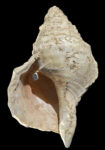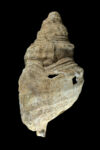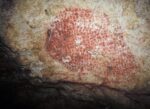 A prehistoric conch shell that was adapted into a musical instrument 18,000 years ago has been played again. Discovered in 1931 at the entrance to the Maroulas cave located in the foothills of the Pyrenees in southwestern France, it is the earliest known conch shell horn in the world and the only prehistoric one.
A prehistoric conch shell that was adapted into a musical instrument 18,000 years ago has been played again. Discovered in 1931 at the entrance to the Maroulas cave located in the foothills of the Pyrenees in southwestern France, it is the earliest known conch shell horn in the world and the only prehistoric one.
When it was first published in 1933, the Charonia lampas shell was believed to be a “loving cup,” a ceremonial drinking vessel. Its broken apex and outer lip were presumed to be natural damage, not the result of human intervention. Acclaimed at the time as an “exceptional discovery,” the shell entered the collection of the Natural History Museum of Toulouse and faded into obscurity until 2016 when researchers looked at it with fresh eyes and even fresher technology as part of a study of the cultural context of the Maroulas cave paintings.
 Analysis with modern imaging techniques found that the shell was in fact deliberately altered by the late Upper Palaeolithic Magdalenian people who occupied the cave. CT scans, photogrammetry and examination with a medical camera found considerable evidence of human transformation of the shell that enabled it to be blown. The apex of the shell, the toughest part of it, was broken off deliberately by being repeatedly struck. This could not have happened accidentally, by wave action when it was still in the ocean, say.
Analysis with modern imaging techniques found that the shell was in fact deliberately altered by the late Upper Palaeolithic Magdalenian people who occupied the cave. CT scans, photogrammetry and examination with a medical camera found considerable evidence of human transformation of the shell that enabled it to be blown. The apex of the shell, the toughest part of it, was broken off deliberately by being repeatedly struck. This could not have happened accidentally, by wave action when it was still in the ocean, say.
A hole running from the break in the apex into the interior of the shell is also man-made. It is extremely narrow with regular striations on its edge,  indicating that it was drilled. Researchers believe the apex was destroyed and the hole was created so a tubular mouthpiece, the hollow bird of a bone, for example, could be mounted to the shell. A residue of brown organic matter along the broken edge of the apex may be the remains of a resin or wax used to adhere the mouthpiece, something seen in less ancient examples of conch horns found in Syria and New Zealand. The labrum, the outer lip of the shell was also chipped off to make a finer, more regular edge.
indicating that it was drilled. Researchers believe the apex was destroyed and the hole was created so a tubular mouthpiece, the hollow bird of a bone, for example, could be mounted to the shell. A residue of brown organic matter along the broken edge of the apex may be the remains of a resin or wax used to adhere the mouthpiece, something seen in less ancient examples of conch horns found in Syria and New Zealand. The labrum, the outer lip of the shell was also chipped off to make a finer, more regular edge.
 Enhanced imaging further revealed faded remains of red ochre pigment dots on the columella (the inside of the wide opening) that are very similar to ones used to form a bison image on the wall of the cave. There are also very fine engravings under the pigment on the inner lip of the shell opening.
Enhanced imaging further revealed faded remains of red ochre pigment dots on the columella (the inside of the wide opening) that are very similar to ones used to form a bison image on the wall of the cave. There are also very fine engravings under the pigment on the inner lip of the shell opening.
The musical dimension of the conch shell from Marsoulas provides outstanding information on the symbolic activities linked to cave art. […]
We now have strong evidence that the Marsoulas shell comes from the archaeological level attributed to the beginning of the Magdalenian period. Its decoration with red pigments and graphic elements that exist on the walls of the cave supports this attribution. This is the first time that a symbolic link is attested between an ornate cave and a musical instrument. As with art, music is a production of social interactions. The strong link that must exist between image and sound certainly had a social function, which was to take its importance in social practices and rituals.
To test whether the shell was playable, the research team enlisted the aid of a musicologist and wind instrument specialist from the University of Toulouse. Jean-Michel Court played it by vibrating his lips as when playing a trumpet or trombone. Different notes depend on the tension of the lips and the amount of air blown into the cavity. Even with the sharp edges of the apex posing a grave risk of lip injury, Court was able to produce three distinct notes from the shell horn — C, D and C sharp.
Here they are: